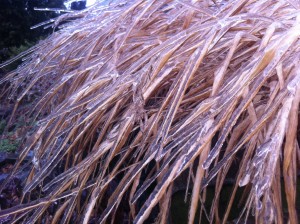
A Busy (and Beautiful) Winter Garden
Winter often seems like an “off” season for the garden. There are no blooms, no butterflies, and many of the birds have flown south. But for those of us who live in a temperate climate, there are still a lot of things happening in the landscape.
For one, the cold is an important part of a plant’s life cycle. Dormancy allows a plant to save energy for the following season’s growth. It allows the plant to weather below-freezing temperatures without damage. Cold is required for many seeds to germinate.
Snow introduces small amounts of nitrogen into the soil. Snow insulates the ground, keeping it frozen, and helping to prevent frost heave. It also helps plants from sprouting too soon during un-seasonally warm weather. Microbial activity also continues at low temperatures. These microbes are important because they help break down soil nutrients to a form that plants can use. Plants don’t directly “eat” the soil, instead they have a symbiotic relationship with the soil microbes that help them utilize the nutrients. If you have happy, healthy soil, your soil microbes will still be busy during the winter.
Any remaining foliage, dead leaves, and coniferous trees and shrubs can provide a multitude of insects, birds, and animals with protection or food.
Ecological Landscaping Techniques
Many people advocate removing dead plant matter from the landscape in the fall. Although there is a chance of voles using leaf litter as protection and causing damage, there are many reasons. Learn which plants to remove leaf litter from and which can remain. Fruit trees and roses benefit from removing debris which can harbor fungal disease or pests from the ground under them. Elsewhere in the garden, this leaf litter serves many important functions. Read the pamphlet for a more detailed discussion: Life in the Leaf Litter (1.7 MB pdf)
Remember that keeping raw materials on-site is efficient and sustainable. It returns nutrients in your garden back to the soil and it decreases your town’s cost and fuel requirements for landscape waste removal and processing.
Plant Choices
Native plants often provide many more ecological benefits than introduced species, including cultivars. For instance, Rutgers hybrid dogwoods, a cross between kousa and native dogwoods, are sterile (meaning they do not produce seeds that will produce more plants) and the cultivar is more resistant to insects and disease. Also, the berries of the some plant cultivars, like ‘Winter Sprite’ winterberry, are not eaten as readily by birds as the native winterberry. If you mourn the fact that the berries of a plant are eaten by birds too quickly and you can’t enjoy the red color throughout winter, consider planting both a native and a cultivar. That way, you will not deprive the birds of an important winter food source. Your plant choices have an impact on other things beside the designed space, so if you are trying to have a sustainable or ecologically-friendly landscape, read about the plants you are considering or consult reliable sources like the New England Wildflower Society.

Ice Covered Grasses
Remember that some berry producing plants, like hollies, are dioecious and require both a male and female plant in order for the female to produce fruit. It is also important to plant species that are appropriate for the site based on the plant’s requirements for moisture, soil type, heat, cold, and light.
Natural Architecture
Another thing that I enjoy about plants in winter is that they provide striking architecture in the winter garden. This is one of the reasons that I don’t remove dead plants until spring. It isn’t just the coniferous trees and shrubs – I enjoy seeing the snow and ice on most of my plants.
I hope that despite the overwhelming amount of snow this season, you can find beauty in the important ways that the snow and cold weather provide valuable ecological services to our environment. Grab your snowshoes and go look for something unexpected!
